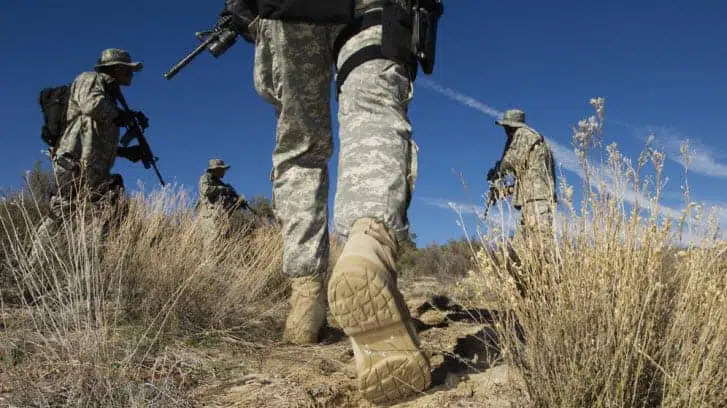All About New Jersey Military Bases & History
Important Note: When you buy through our links, we may earn a commission. As an Amazon Associate we earn from qualifying purchases. Content, pricing, offers and availability are subject to change at any time - more info.
The United States is well known for having one of the most powerful military forces in the world. New Jersey contributes to this by having many more operational bases than most of the other states. Let’s take a look at them and dive into their history.
New Jersey has many more military bases than some of the other 50 states. They are lined with a rich history with some construction dating back to the Revolutionary War. Some bases include Mcguire, Fort Dix, Picatinny, Loran, the Cape May Coast Guard Center, NWS Earle Navy base, and NAES.
This article will outline and then go over the history of New Jersey and its operational military bases. It dives deep into when these bases were constructed, how they were named, and their current function and utility.
All About New Jersey Military Bases And History
The state of New Jersey has many more military installations compared to the other states in the USA. However, it does not feature a USMC (United States Marine Corps). Over the course of time, some military bases and installations were opened and shut down.
We will be discussing the current operational bases in New Jersey. These are namely;
- Mcguire Air force Base
- Fort Dix Army Base
- Picatinny Arsenal Army Base
- Loran Support Unit Coast Guard Base
- Training Center Cape May Coast Guard Base
- NWS Earle Navy Base
- NAES Lakehurst Navy Base
Here is a list of all the installations that have been built throughout New Jersey’s history.
- Atlantic City Armory
- Atlantic City Range
- Battery Kingman
- Camp Merrit
- Campgaw Mountain Reservation
- Federal Shipbuilding and Drydock Company
- Fort Dix
- Fort Hancock
- Fort Monmouth Army Base
- Highlands Army Air Defense Site
- Intelligence And Information warfare Directorate
- Jersey City Armory
- Joint Base Mcguire-Dix-Lakehurst
- Lakehurst Hangar No.1
- Lakehurst Maxfield Field
- Military Ocean Terminal At Bayonne
- Naval Air Warfare Center Trenton
- Naval Weapons Station Earle
- Paterson Armory
- Plainfield Armory
- USS Rancocas
- Sandy Hook Proving Ground
- Sievers Sandaberg Reserve Cente
- Teaneck Armory
- United States Air Force Expeditionary Center
- United States Coast Guard Training Venter Cap May
Before we jump into the currently active military bases in New Jersey, it should be essential to understand its history and why the military has such a presence in this state.
In its history, New Jersey was under Great Britain’s rule and declared its independence in 1776. It did so along with 12 other colonies, thus becoming one of the USA’s original states as represented by one of the 13 stars on the original flag. New Jersey is now home to a population of almost 9 million, with an estimated 5% of them being veterans.
The original flag declaring its independence was designed in 1777 and then redesigned in 1928. The flag features a coat of arms; coincidentally, the color was that of the Continental Army during the Revolutionary war.
The flag pays tribute to New Jersey’s rich history in agriculture with three plows. The coat of arms is adorned with a knight’s helmet, on top of which sits a horse’s head, indicative of New Jersey’s sovereignty and the horse being the state’s animal since 1977.
Alongside the shield stands two female figures. On the left stands Phrygian and on the right Ceres. These two figures represent the state’s motto, “Liberty and Prosperity.”.
Mcguire Air Force Base
This base was constructed in preparation for the second world war and was opening in 1941. However, it did not play a significant role and was subsequently shut down. Luckily it was reestablished in 1948 and is currently run by The Air Force under one of its branches; The Air Mobility Command.
The name of the base was given to it in memory of the second most important Ace in the United States’ history. An ace is a pilot who is credited with shooting down five enemy aircraft during aerial combat.
It currently hosts the 621st Contingency Response Wing, the 87th Air Base wing, and all its subdivisions.
Fort Dix Army Base
Fort Dix is part of the Joint Base Mcguire Dix Lakehurst. It merged with complementary camps in order to bolster its forces. It is located in the middle of the state 25km south of Trenton, and is operated by the US Air Force.
The base was initially known as Camp Dix and used to stage and train soldiers during the first world war. After the war, it was converted into a civilian reception and training field. A few years prior to the second world war, it was upgraded and given its current name (Fort Dix). The name was given to the base in memory and honor of John Adams Dix, a Civil war veteran and one of the war in 1812.
The for remained operational after the war becoming a base for basic training, and it saw a few adjustments and upgrades when the Vietnam War started. This included a full-scale village that was built within the fort in order to train combatants prior to their tours.
It is now home to the 87th Air Base Wing, which includes all of its subdivisions and groups.
Picatinny Arsenal Army Base
Picatinny Arsenal Army Base is run by the US government and is known for researching and manufacturing weapons.
The function of the base stems all the way back to the Civil War. Due to the fact that many weapon reserves and depots were located in the eastern and southern parts of the country, they were overtaken by Confederate forces.
The government, thus, established depots close to cities, and Dover Powder Depot was constructed in 1880 and, within a few days, was renamed to what it is today. While mainly functioning as a storage depot, many expansions and improvements took place, constructing the first powder factory in 1907.
Between 1910 and 1920, the base trained soldiers in weaponry sciences and began manufacturing artillery ammunition for the first world war.
The base is known for its 18,000 workers that produced ammunition for the second world war, along with the devastation that occurred in 1926 when lightning struck the base and detonated millions of pounds of ammunition.
Loran Support Unit Coast Guard Base
Loran Support Unit, under the command of Gary Thomas, is situated in Wildwood, New Jersey. The base is responsible for the Long Range Navigation System (LRNS). It supports the US Coast guard on the Western shores and that of all other ships and aircraft (including privately owned ones).
This navigation system helps aviators and sailors navigate and locate themselves in US waters, helping them to pinpoint their position. Take into consideration that it was solely responsible for this task before the invention of GPS. Now that GPS is widely available, the LRNS is losing its foothold.
By the time GPS gets fully rooted in the US Army and Navy, the LRNS will be abolished, and perhaps the base will be disestablished.
Training Center Cape May Coast Guard Base
Training Center Cape May was initially a refuge site during the Revolutionary War. In 1917 the Navy converted it into a training facility that featured defensive coastal operations. It subsequently burnt down in 1918 due to an accident but was quickly rebuilt, and at the end of the first world war, the largest hangar in history (at the time) was built to design the most advanced aerial planes.
In 1924 the United States Coast Guard took over the base, and it is now one of the most important training centers for new recruits wishing to join the Coast Guard. It is under the command of Captain William G. Kelly and is apparently the only recruiting center in the USA of its kind.
NWS Earle Navy Base
The NWS Earle Navy Base was established in the midst of the second world was due to the government wanting to develop multiple depots around the country. Construction was completed in 1943 and was named after Ralph Earle, who was a US Navy command officer during the first world war.
The United States Navy operates it, and its role is to support all operations that are conducted by the Department of Defense. IT deals in weaponry equipment, storing, repairing, developing, and maintaining the most advanced weaponry the US Navy has to offer.
NAES Lakehurst Navy Base
NAES Lakehurst Navy Base we initially known as Camp Kendrick and was constructed in 1917. At first, it was under the control of the US Army; however, in 1921, the US Navy took command of the base.
It is infamously known for the disaster that took place in 1937, which was referred to as the “Hindenburg disaster.”. A German airship was destroyed, killing 36 individuals.
Its purpose is to deal with aviation in the northeastern parts of the USA. For example, NAVAIR is responsible for aircraft missions and is the world’s largest and most advanced unit.
The base is further responsible for dealing with all aircraft recovery and launch that covers all spectrums of operations and sessions.
Summing up New Jersey Military Bases
As we found out, New Jersey has many military bases that are home to thousands of American Army and Navy soldiers. There are almost 8,000 active-duty soldiers currently residing here, spread out over the many bases we discussed.
Many of these installations have a long and rich history, some even dating back to the Revolutionary (Civil War). Although many have been established and decommissioned, the many bases that are still operational pay tribute to New Jersey’s military history.






